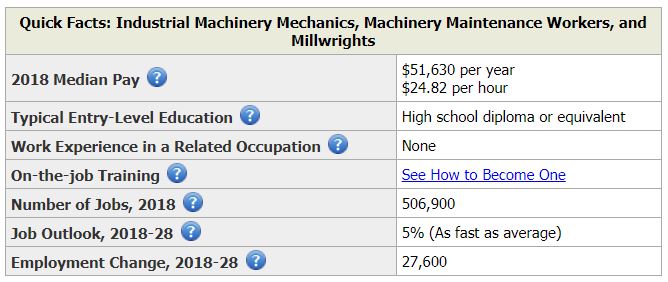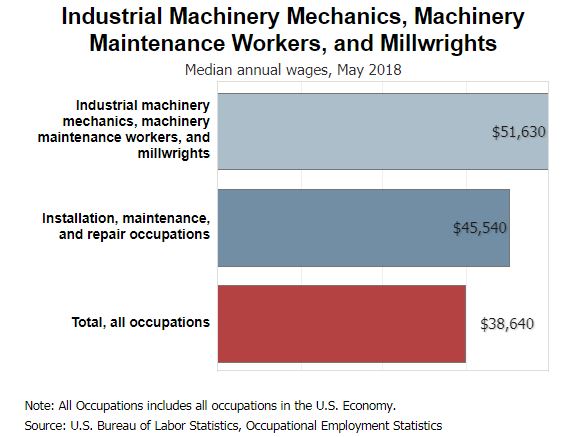Industrial Machinery Mechanic
Angela | December 11, 2019
752 Views
77 Likes
4.75
On 16 Ratings
Related
Industrial Machinery Mechanic
Industrial machinery mechanics and machinery maintenance workers maintain and repair factory equipment and other industrial machinery, such as conveying systems, production machinery, and packaging equipment. Millwrights install, dismantle, repair, reassemble, and move machinery in factories, power plants, and construction sites.

Industrial machinery mechanics, machinery maintenance workers, and millwrights typically do the following:
- Read technical manuals to understand equipment and controls
- Disassemble machinery and equipment when there is a problem
- Repair or replace broken or malfunctioning components
- Perform tests and run initial batches to make sure that the machine is running smoothly
- Detect minor problems by performing basic diagnostic tests
- Test malfunctioning machinery to determine whether major repairs are needed
- Adjust and calibrate equipment and machinery to optimal specifications
- Clean and lubricate equipment or machinery
- Move machinery and equipment
Industrial machinery mechanics, also called maintenance machinists, keep machines in working order by detecting and correcting errors before the machine or the products it produces are damaged. Many of these machines are increasingly run by computers. Industrial machinery mechanics use technical manuals, their understanding of industrial equipment, and observation to determine the cause of a problem. For example, after detecting a vibration from a machine, they must decide whether it is the result of worn belts, weak motor bearings, or some other problem. They may use computerized diagnostic systems and vibration analysis techniques to help figure out the source of problems. Examples of machines they may work with are robotic welding arms, automobile assembly line conveyor belts, and hydraulic lifts.
After diagnosing a problem, the industrial machinery mechanic may take the equipment apart to repair or replace the necessary parts. Once a repair is made, mechanics test a machine to ensure that it is operating correctly.
In addition to working with hand tools, mechanics commonly use lathes, grinders, and drill presses. Many also are required to weld.
Machinery maintenance workers do basic maintenance and repairs on machines. They clean and lubricate machinery, perform basic diagnostic tests, check the performance of the machine, and test damaged machine parts to determine whether major repairs are necessary.
Machinery maintenance workers must follow machine specifications and adhere to maintenance schedules. They perform minor repairs, generally leaving major repairs to industrial machinery mechanics.
Maintenance workers use a variety of tools to do repairs and preventive maintenance. For example, they may use a screwdriver or socket wrenches to adjust a motor’s alignment, or they might use a hoist to lift a heavy printing press off the ground.
Millwrights install, maintain, and disassemble industrial machines. Putting together a machine can take a few days or several weeks.
Millwrights perform repairs that include replacing worn or defective parts of machines. They also may be involved in taking apart the entire machine, a common situation when a manufacturing plant needs to clear floor space for new machinery. In taking apart a machine, millwrights carefully disassemble, categorize, and package each part of the machine.
Millwrights use a variety of hand tools, such as hammers and levels, as well as equipment for welding, brazing, and cutting. They also use measuring tools, such as micrometers, measuring tapes, lasers, and other precision-measuring devices. On large projects, they commonly use cranes and trucks. When millwrights and managers determine the best place for a machine, millwrights use forklifts, hoists, winches, cranes, and other equipment to bring the parts to the desired location.
ndustrial machinery mechanics, machinery maintenance workers, and millwrights held about 506,900 jobs in 2018. Employment in the detailed occupations that make up industrial machinery mechanics, machinery maintenance workers, and millwrights was distributed as follows:
| Industrial machinery mechanics | 381,500 |
| Maintenance workers, machinery | 81,100 |
| Millwrights | 44,300 |
The largest employers of industrial machinery mechanics, machinery maintenance workers, and millwrights were as follows:
| Manufacturing | 53% |
| Wholesale trade | 10 |
| Commercial and industrial machinery and equipment (except automotive and electronic) repair and maintenance | 9 |
| Construction | 6 |
Injuries and Illnesses
Working with industrial machinery can be dangerous. To avoid injury, workers must follow safety precautions and use protective equipment, such as hardhats, safety glasses, steel-toed shoes, gloves, and earplugs.
Work Schedules
Most industrial machinery mechanics and machinery maintenance workers are employed full time during regular business hours. However, mechanics may be on call and work night or weekend shifts. Overtime is common, particularly for mechanics.
ndustrial machinery mechanics, machinery maintenance workers, and millwrights typically need a high school diploma. Industrial machinery mechanics and machinery maintenance workers also usually need a year or more of training after high school.
Most millwrights go through an apprenticeship program that lasts about 4 years.
Education
Industrial machinery mechanics, machinery maintenance workers, and millwrights generally need at least a high school diploma or equivalent. Some mechanics and millwrights complete a 2-year associate’s degree program in industrial maintenance. Industrial maintenance programs may include courses such as welding, mathematics, hydraulics, and pneumatics.
Training
Industrial machinery mechanics and machinery maintenance workers typically receive more than a year of on-the-job training. Industrial machinery mechanics and machinery maintenance workers learn how to perform routine tasks, such as setting up, cleaning, lubricating, and starting machinery. They also may be instructed in subjects such as shop mathematics, blueprint reading, proper hand tool use, welding, electronics, and computer programming. This training may be offered on the job by professional trainers hired by the employer or by representatives of equipment manufacturers.
Most millwrights learn their trade through a 3- or 4-year apprenticeship. For each year of the program, apprentices must have at least 144 hours of relevant technical instruction and up to 2,000 hours of paid on-the-job training. On the job, apprentices learn to set up, clean, lubricate, repair, and start machinery. During technical instruction, they are taught welding, mathematics, how to read blueprints, and machinery troubleshooting. Many also receive computer training.
After completing an apprenticeship program, millwrights are considered fully qualified and can usually perform tasks with less guidance.
Employers, local unions, contractor associations, and the state labor department often sponsor apprenticeship programs. The basic qualifications for entering an apprenticeship program are as follows:
- Minimum age of 18
- High school diploma or equivalent
- Physically able to do the work
Important Qualities
Manual dexterity. Industrial machinery mechanics, machinery maintenance workers, and millwrights must have a steady hand and good hand–eye coordination when handling very small parts.
Mechanical skills. Industrial machinery mechanics, machinery maintenance workers, and millwrights use technical manuals and sophisticated diagnostic equipment to figure out why machines are not working. Workers must be able to reassemble large, complex machines after finishing a repair.
Troubleshooting skills. Industrial machinery mechanics, machinery maintenance workers, and millwrights must observe, diagnose, and fix problems that a machine may be having.
The median annual wage for industrial machinery mechanics, machinery maintenance workers, and millwrights was $51,630 in May 2018. The median wage is the wage at which half the workers in an occupation earned more than that amount and half earned less. The lowest 10 percent earned less than $33,010, and the highest 10 percent earned more than $77,790.

Median annual wages for industrial machinery mechanics, machinery maintenance workers, and millwrights in May 2018 were as follows:
| Millwrights | $55,060 |
| Industrial machinery mechanics | 52,340 |
| Maintenance workers, machinery | 47,060 |
In May 2018, the median annual wages for industrial machinery mechanics, machinery maintenance workers, and millwrights in the top industries in which they worked were as follows:
| Manufacturing | $51,850 |
| Construction | 51,640 |
| Wholesale trade | 49,700 |
| Commercial and industrial machinery and equipment (except automotive and electronic) repair and maintenance | 47,120 |
Most industrial machinery mechanics and machinery maintenance workers are employed full time during regular business hours. However, mechanics may be on call or assigned to work night or weekend shifts. Overtime is common, particularly for mechanics.
Overall employment of industrial machinery mechanics, machinery maintenance workers, and millwrights is projected to grow 5 percent from 2018 to 2028, about as fast as the average for all occupations. Employment growth will vary by occupation.

The increased adoption of sophisticated manufacturing machinery will require more mechanics and millwrights to keep machines in good working order. Increased automation, including the use of many computer-controlled machines in factories and manufacturing plants, should raise the demand for machinery maintenance workers in order to keep the machines functioning properly. The increased use of machinery in manufacturing will require millwrights to install and disassemble this equipment, as well as perform some repair work on it.
Job Prospects
Job prospects will be good, particularly for applicants with a broad range of skills in machine repair as older workers retire or otherwise leave the occupation.
Bureau of Labor Statistics, U.S. Department of Labor, Occupational Outlook Handbook, Industrial Machinery Mechanics, Machinery Maintenance Workers, and Millwrights,
on the Internet at https://www.bls.gov/ooh/installation-maintenance-and-repair/industrial-machinery-mechanics-and-maintenance-workers-and-millwrights.htm (visited November 23, 2019).
Salary information comes from the Bureau of Labor Statistics, Occupational Employment Statistics Program, a semi-annual survey that provides wage and employment statistics for the nation, each state, and sub-state regions.
Tagged as AC, Amarillo College, Beef Capital of the World, Career, Cattle, Caviness Beef Packers, Clarendon College, Education, Engineering, Frank Phillips College, Hereford, Hometown Success, Industrial Machinery Mechanic, Jobs Ya'll, Occupation, Region 16, Rural Community, Texas, Texas Panhandle, Texas Tech University, Texas Workforce Commission, West Texas A&M University, Workforce Solutions Panhandle.
Written by Angela












